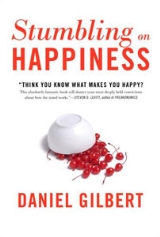
Stumbling on Happiness
Encyclopedia
Stumbling on Happiness is a non-fiction book by Daniel Gilbert. It was published in the United States
and Canada
in 2006 by Knopf, and has been translated into 20 languages. It is a New York Times bestseller
.
is that, through perception and cognitive bias
es, people imagine the future poorly, in particular what will make them happy. He argues that imagination fails in three ways:
The advice Gilbert offers is to use other people's experiences to predict the future, instead of imagining it. It is surprising how similar people are in much of their experiences, he says. He does not expect too many people to heed this advice, as our culture, accompanied by various thinking tendencies, is against this method of decision making.
Also, Gilbert covers the topic of 'filling in' or the frequent use of patterns, by the mind, to connect events which we do actually recall with other events we expect or anticipate fit into the expected experience. This 'filling in' is also used by our eyes and optic nerves to remove our blind spot or scotoma
, and instead substitute what our mind expects to be present in the blind spot.
This accessible book is written for the layperson, generally avoiding abstruse terminology and explaining common quirks of reasoning through the simple experiments that exploited them (this excludes the term "super-replicator").
United States
The United States of America is a federal constitutional republic comprising fifty states and a federal district...
and Canada
Canada
Canada is a North American country consisting of ten provinces and three territories. Located in the northern part of the continent, it extends from the Atlantic Ocean in the east to the Pacific Ocean in the west, and northward into the Arctic Ocean...
in 2006 by Knopf, and has been translated into 20 languages. It is a New York Times bestseller
Bestseller
A bestseller is a book that is identified as extremely popular by its inclusion on lists of currently top selling titles that are based on publishing industry and book trade figures and published by newspapers, magazines, or bookstore chains. Some lists are broken down into classifications and...
.
Summary
Gilbert's central thesisThesis
A dissertation or thesis is a document submitted in support of candidature for an academic degree or professional qualification presenting the author's research and findings...
is that, through perception and cognitive bias
Cognitive bias
A cognitive bias is a pattern of deviation in judgment that occurs in particular situations. Implicit in the concept of a "pattern of deviation" is a standard of comparison; this may be the judgment of people outside those particular situations, or may be a set of independently verifiable...
es, people imagine the future poorly, in particular what will make them happy. He argues that imagination fails in three ways:
- Imagination tends to add and remove details, but people do not realize that key details may be fabricated or missing from the imagined scenario.
- Imagined futures (and pasts) are more like the present than they actually will be (or were).
- Imagination fails to realize that things will feel differently once they actually happen -- most notably, the psychological immune system will make bad things feel not so bad as they are imagined to feel.
The advice Gilbert offers is to use other people's experiences to predict the future, instead of imagining it. It is surprising how similar people are in much of their experiences, he says. He does not expect too many people to heed this advice, as our culture, accompanied by various thinking tendencies, is against this method of decision making.
Also, Gilbert covers the topic of 'filling in' or the frequent use of patterns, by the mind, to connect events which we do actually recall with other events we expect or anticipate fit into the expected experience. This 'filling in' is also used by our eyes and optic nerves to remove our blind spot or scotoma
Scotoma
A scotoma is an area of partial alteration in one's field of vision consisting of a partially diminished or entirely degenerated visual acuity which is surrounded by a field of normal - or relatively well-preserved - vision.Every normal mammalian eye has a scotoma in its field of vision, usually...
, and instead substitute what our mind expects to be present in the blind spot.
This accessible book is written for the layperson, generally avoiding abstruse terminology and explaining common quirks of reasoning through the simple experiments that exploited them (this excludes the term "super-replicator").
Recognition
In 2007, the book was awarded the Royal Society Prizes for Science Books general prize for the best science writing for a non-specialist audience.External links
- Stumbling on Happiness web site. includes a blog
- Reviews of Stumbling on Happiness
- Publisher's website for Stumbling on Happiness
- Short interview about the book from SXSWi 2006
- Comprehensive interview on the book
- Video of Gilbert discussing humans' failure to predict what makes us happy. Presented July 2005 at the TED Conference in Oxford, UK. Duration: 22:02
- Gilbert's Profile Page on UK publisher's blog, fifthestate.co.uk

